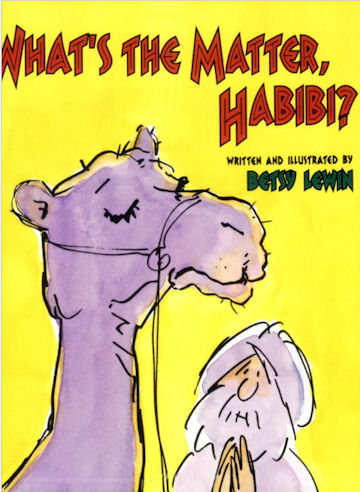
1. BIBLIOGRAPHY
Lewin, Betsy.
1997. WHAT'S THE MATTER,
HABIBI? Ill. by Betsy Lewin. New York, NY: Clarion Books. ISBN
039585816X
2. PLOT SUMMARY
Betsy Lewin tells the story of Habibi, a camel who gives rides to children daily, but
suddenly, decides he no longer wants to.
He refuses to obey the promptings of his owner, Ahmed. Ahmed grows worried, wondering if his beloved
camel is ill. Habibi runs away in search
of what he truly wants, while Ahmed wildly chases after him. In the end, both Ahmed and Habibi are happily
reunited, each having gotten what they wanted.
3. CRITICAL ANALYSIS
Lewin's writing is straightforward in this story of a camel
and the journey he takes his owner on.
She uses onomatopoeia to mimic the sounds of Habibi's feet striking the
ground, "ploppity-plop" and "slappity-slap", which
playfully add to Habibi's strong-willed personality. Lewin also introduces her readers to names
and words they may have never heard of before: Habibi, Ahmed, babouches, and
fezzes. Although the words are used to
further the plot to engage the reader, it is the use of sketching techniques and
water color illustrations that anchor the heart of telling this story.
The illustrations provide crucial clues in helping readers
determine that babouches are slippers and a fez is a hat. The illustrations also serve to establish the
cultural setting and environment. The
pictures reveal that the story takes place in a foreign country, perhaps in
Morocco or the Middle East. As readers
turn the pages, they see sights that are common to Arabic nations: men wearing turbans and thobes, women wearing
kameezes with the protective hijab, and crowded food markets flourishing with
activity. One page has an image of two
men hookah smoking. Although this detail
is never mentioned in the story, it is an authentic image that captures the
customs of everyday life of the culture.
Lewin's bold lined sketches and
shadings help to capture the intricate shapes found in the brass and tin shops as
well as the details found in the building spires and arched, columned
doorways. The drawings also reveal the
willful spirit of Habibi, showing his stubborn facials expressions when
refusing to obey Ahmed. The sketched
lines show the movement of Habibi's fez hat and the mount's tassels on his
lively jaunt through the city streets. The
vibrant water colors used for Habibi's mount are used to grab the eye of the
reader and focus on him as the central character of the story. This contrasts the bland and lighter color shades
used for the buildings and people in the market place.
I think this picture book does a
wonderful job of capturing the humor of a strong-willed camel and the lengths
he will go to, to get what he wants. It
also shows young readers the cultural diversity that exists in the world, and
can introduce them to different perspectives and other ways of life. Books such as this one may help to pique
their interests in learning more about the different ethnicities, cultures, and
customs of the world.
4. REVIEW EXCERPTS
BOOKLIST: "Half the charm of
this original picture book is in the free-spirited illustrations. Full of
energy and wit, the bold black line drawings tell the tale, while the colorful
watercolor washes add depth, warmth, and gaiety. With its modern-day Egyptian
setting, timeless story, and fresh, spontaneous style of artwork, this simple
picture book has much to offer."
BOOKFLAP: "Inspired by a
real-life camel and driver Betsy Lewin met in Egypt, this frolicsome new
picture book will delight any child."
PUBLISHER'S WEEKLY: "Lewin's
(Chubbo's Pool) agile, spontaneous-looking watercolors combine graceful scrawls
and squiggles with watercolor washes, humorously depicting the owner's struggle
with his stubborn charge and Habibi's frisky stride through the purple-shadowed
crowds of the bazaar. The art adds a lot of style to little substance--perhaps
fitting for a tale in which the narrative problem is solved by a new hat."
5.
CONNECTIONS
To help students learn more about
Middle Eastern cultures, you can pair this book with the following:
*Kipling, Rudyard. HOW THE CAMEL
GOT HIS HUMP. ISBN 0887080960
*Clayton, Sally Pomme. TALES TOLD IN TENTS: STORIES FROM CENTAL
ASIA. ISBN 1845072782
No comments:
Post a Comment